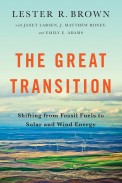Tuesday, October 25, 2011
On October 31, Halloween to some of us, the United Nations Population Fund (UNFPA) predicts that world population will hit 7 billion.
As Lester Brown wrote in 2006 when the population of the United States hit 300 million, this is not a cause for celebration. 
According to a team of scientists led by Mathis Wackernagel, as of 2007, it takes 1.5 Earths to sustain humanity’s current level of consumption. If all 7 billion on Earth lived like an average American, we would require five planets. Clearly our collective demands far exceed the ability of our planet’s natural support systems to sustain us.
A few other facts:
- There will be 219,000 people at the dinner table tonight who were not there last night—many of them with empty plates.
- Over the course of a year, we are adding 78 million new people, or an entire Ethiopia.
- Virtually all of the top 20 countries considered to be “failing states” are depleting their natural assets—forests, grasslands, soils, and aquifers—to sustain their rapidly growing populations. And in these countries, over 50 percent of the population lives in extreme poverty.
- Some 1.4 billion people live in extreme poverty.
- Twenty-two percent of the children in the United States—the richest nation in the world—live in poverty. One fifth are chronically hungry.
- Half the world’s people live in countries where water tables are falling as aquifers are being depleted. Since 70 percent of world water use is for irrigation, water shortages translate into food shortages.
- Over 1 billion people in the world are chronically hungry and malnourished, a number that has been increasing in recent years.

As Brigid Fitzgerald Reading wrote in her recent piece World Population Hitting 7 Billion: “Supporting the world’s human population will mean eliminating poverty, transitioning to an economy that is in sync with the earth, and securing every person’s health, education, and reproductive choice. If we do not voluntarily stabilize population, we risk a much less humane end to growth as the ongoing destruction of the earth’s natural systems catches up with us.”
Lester Brown in World on the Edge writes, “we have the technological and financial resources to eradicate poverty. Investments in education, health, family planning, and school lunches are in a sense a humanitarian response to the plight of the world’s poorest countries. But in the economically and politically integrated world of the twenty-first century, they are also an investment in our future.”
To find out more about our global population and solutions, check out these links.
“Population Pressure: Land and Water,” from Plan B 4.0 by Lester Brown
"Eradicating Poverty and Stabilizing Population," from Plan B 4.0 by Lester Brown
Population Connection
See also the wall chart produced by Population Connection
Population Media Center
Population Action International
Article “Are There Too Many People on the Planet?,” National Geographic
7 Billion: It's Time to Talk campaign working to open up the conversation on population to new audiences around the globe
Sincerely,
Reah Janise Kauffman
Page 1 of 1 pages


